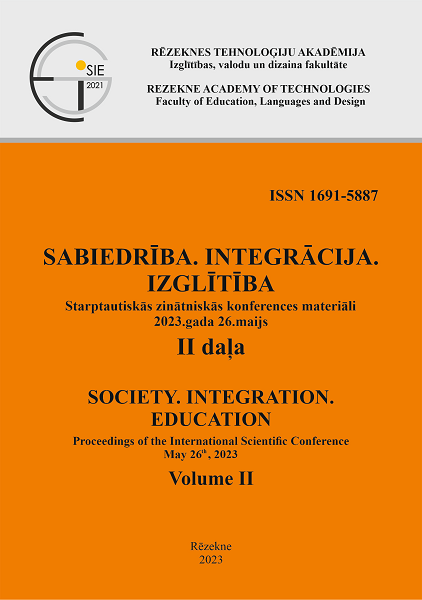PERFORMANCE AND TRAINING PROGRAM CHARACTERISTICS IN ELITE YUNIOR FEMALE ROLLER SKIER FROM 2021 SEASON: A CASE REPORT
DOI:
https://doi.org/10.17770/sie2023vol2.7156Keywords:
aerobic power, heart rate, roller-skiing, training program, workload’s intensity, and volumeAbstract
The purpose was to evaluate the training program, body mass composition, aerobic performance laboratory and field test results, blood hormone concentration in elite junior female roller skier in successful competition season. Methods. Totally 206 training sessions (278 training hours) were analysed during six months (from April till September). Athlete wight and body fat changes were monitored, laboratory tests on a treadmill and field tests were performed and concentration of hormones in the blood was detected. Results. A polarised training intensity distribution was observed. The highest volume of training workloads (70 training hours per month) was achieved in the last month before start of World cup season, this change corelated with change in blood testosterone levels. Heart rate decreased by 7.51% at the anaerobic threshold load intensity and by 10.1% at lower intensity loads. Peak oxygen uptake (VO2max) of 49 ml/kg/min was reached in laboratory test. Increase of lean body mass by 2.4 kg was observed. The progress in 3000m running race time was detected from 14:30 minutes in the beginning of April to 13:16 minutes in June. Conclusion. VO2max in junior elite female roller skier is low in comparison with cross-country skiers, but the training workload intensity and volume are comparable with skiers. This research shows insight in top junior level female roller-skiers physiology and training, but specific values determining the success of this athlete are still to be determined if compared to traditional cross-country skier.
References
Hoff, J., Gran, A., & Helgerud, J. (2002). Maximal strength training improves aerobic endurance performance. Scandinavian Journal of Medicine & Science in Sport, 12(5), 288-295. DOI: https://doi.org/10.1034/j.1600-0838.2002.01140.x
Ingjer, F. (1991). Maximal oxygen uptake as a predictor of performance ability in women and men elite cross‐country skiers. Scandinavian Journal of Medicine & Science in Sports, 1(1), 25-30.
Losnegard, T., & Hallén, J. (2014). Elite cross-country skiers do not reach their running VO2max during roller ski skating. The Journal of Sports Medicine and Physical Fitness, 54(4), 389–393.
Myakinchenko, E. B., Kriuchkov, A. S., Adodin, N. V., & Feofilaktov, V. (2020). The Annual Periodization of Training Volumes of International-Level Cross-Country Skiers and Biathletes. International Journal of Sports Physiology and Performance, 15(8), 1181-1188.
Sandbakk, Ø., Ettema, G. and Holmberg, H.-.-C. (2014), Contribution from poling on gender differences. Scandinavian Journal of Medicine & Science in Sports, 24, 28-33. DOI: https://doi.org/10.1111/j.1600-0838.2012.01482.x
Sandbakk, Ø., Hegge, A. M., Ettema, G. (2013). The role of incline, performance level, and gender on the gross mechanical efficiency of roller ski skating. Frontiers in Physiology, 4, article 293. Retrieved from: https://www.frontiersin.org/articles/10.3389/fphys.2013.00293/full
Sandbakk, Ø., Hegge, A. M., Losnegard, T., Skattebo, Ø., Tønnessen, E., & Holmberg, H. C. (2016). The Physiological Capacity of the World's Highest Ranked Female Cross-country Skiers. Medicine & Science in Sports & Exercise, 48(6), 1091–1100. DOI: https://doi.org/10.1249/MSS.0000000000000862
Sandbakk, Ø., Holmberg, H. C., Leirdal, S., & Ettema, G. (2011). The physiology of world-class sprint skiers. Scandinavian Journal of Medicine & Science in Sports, 21(6), e9–e16. DOI: https://doi.org/10.1111/j.1600-0838.2010.01117.x
Seeberg, T.M., Danielsen, J., Noordhof, D.A., Skovereng, K., Haugnes, P., Tjønnås, J., Sandbakk, Ø. (2021). Physiological and biomechanical determinants of sprint ability following variable intensity exercise when roller ski skating. Frontiers in Physiology, 12, article 638499. Retrieved from: https://www.frontiersin.org/articles/10.3389/fphys.2021.638499/full
Seiler, K. S., & Kjerland, G. Ø. (2006). Quantifying training intensity distribution in elite endurance athletes: is there evidence for an "optimal" distribution? Scandinavian Journal of Medicine & Science in Sports, 16(1), 49–56. DOI: https://doi.org/10.1111/j.1600-0838.2004.00418.x
Starczewski, M., Żmijewski P., Witek, K., Klusiewicz A. (2019). Physiological aspects of different roller skiing techniques in field conditions. Journal of Human Kinetics, 66, 111-120. Retrieved from: https://www.ncbi.nlm.nih.gov/pmc/articles/PMC6458566/
Talsnes, R.K., Solli, G.S., Kocbach, J., Torvik, P. Ø., Sandbakk, Ø. (2021). Laboratory- and field-based performance predictions in cross-country skiing and roller-skiing. Plos One, 16(8), 17 p., e0256662. DOI: https://doi.org/10.1371/journal. pone.0256662






